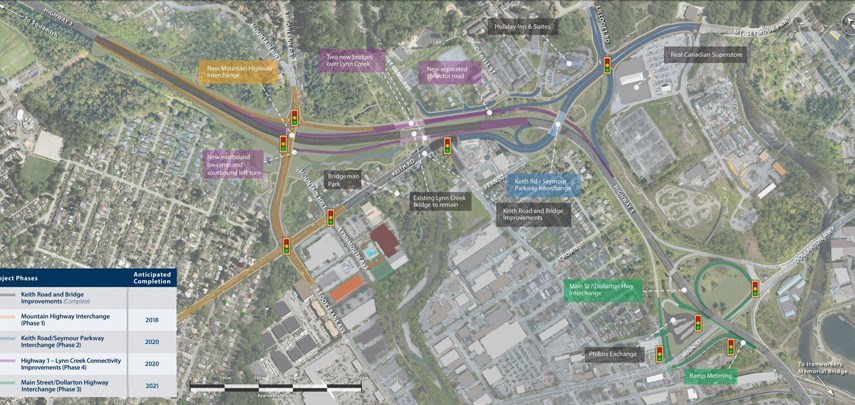The province has debuted its updated plans for $200 million worth of engineering and concrete to break up the notorious traffic congestion on Highway 1.
The Ministry of Transportation and Infrastructure has been working for years on plans to revamp the interchanges at the Ironworkers Memorial Second Narrow Crossing in a multi-phase project expected to last until 2021.
“The traffic in this section of Highway 1 is one of the slowest in the region. Your average speed goes down to like 15 kilometres per hour,” said Jay Porter, project manager. “Obviously, traffic congestion on the North Shore is a huge issue. We’re trying to improve the traffic on and off the North Shore. To do that, we’re going to be upgrading the interchanges to current standards.”
Though right now it may look more like a clear-cut forest with mounds of dirt, the new Mountain Highway overpass, including a new northbound on-ramp for Highway 1 and traffic lights at Keith Road is expected to be ready to go this fall and remains on budget, according to Porter.
As part of that project, crews have already built a five-metre-wide pedestrian/cycling tunnel under Mountain Highway connecting trails south of the highway. Two four-metre high sound barriers are also coming to keep the surrounding neighbourhoods shielded from highway noise.
Sometime in 2020, the ministry expects to complete the next two phases, which include two new bridges over Lynn Creek alongside the existing orange bridge. Those will have the effect of separating express lanes destined for the bridgehead from collector lanes, meaning people headed into the Seymour or Deep Cove area will no longer have to share space with commuters bound for Burnaby, Vancouver or the Fraser Valley.

By the end of 2021, the final phase at Dollarton/Main Street entrance should be complete. Engineers are planning to combine Dollarton on-ramp, with its notoriously short yield lane, and the Main Street on-ramp with a new overpass. Traffic from Dollarton and Main onto the bridge will be throttled with a signalling system.
TO SEE A FULL SIZE VERSION OF THE ABOVE MAP, CLICK HERE.
“As far as I know this will probably be the only one that will be operational in the Lower Mainland but I think you’ll probably see more in the future,” Porter said. “It’s a smart system. Basically there will be sensors on the ramps. It will be able to determine where the volumes are and then the metering system will adjust so it will flush out wherever the volume is greater.”
Drivers getting off the highway at Main Street westbound will have an extra lane, but there will also be a new traffic light at Main Street intended to make that stretch safer for cyclists and pedestrians, Porter said.
“I think it’s going to be kind of a template moving forward for other intersections. So that is a huge improvement,” he said.
Staff will be doing a safety audit of the eastbound off-ramp to see what changes can be made there, Porter added.
Though there are no plans in the offing for a new Ironworkers bridge anytime in the future, the improvements should reduce the number of collisions that tend to cripple the highway.
“On average there’s an incident in the Lower Lynn area every two and a half days. With the improvements that we’re proposing, we feel that it will eliminate 20 to 35 per cent of the incidence,” he said.
Cost for the $200-million project is being shared by the province ($76.7 million) and federal government ($66.6 million), as well as District of North Vancouver taxpayers, who are contributing $54.7 million.



